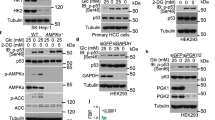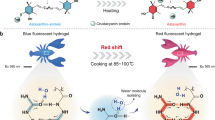Abstract
The development of H2O2-responsive fluorescent glycopolymers with high specificity, sensitivity, and water solubility is a promising strategy for developing probes to detect the production and delivery of endogenous H2O2. Herein, two series of fluorescent glycopolymers (boronic acid derivatives, PG-PFE, and borate derivatives, PG-PFW) were synthesized through esterification and the Williamson reaction, respectively. To increase the sensitivity of the fluorescent glycopolymers, the effect of the reaction conditions on the grafting ratio was investigated in detail. Compared with the PG-PFE samples, the PG-PFW samples had a higher grafting ratio due to the highly efficient Williamson reaction. The structure and properties of the fluorescent glycopolymers were characterized by using nuclear magnetic resonance spectroscopy, gel permeation chromatography, ultraviolet spectroscopy, and photoluminescent spectroscopy. The obtained results showed that all of these fluorescent glycopolymers had good water solubility, low cytotoxicity, and selective responsiveness toward H2O2. HPG-PFW-5, with the highest grafting ratio, displayed a higher sensitivity toward H2O2 and higher stability during hydrolysis than the other materials. In confocal laser scanning microscope images, all of the fluorescent glycopolymers were observed only in cellular mitochondria, and HPG-PFW-5 exhibited a high degree of overlap with Mitotracker Red because of its high sensitivity.
Similar content being viewed by others
Log in or create a free account to read this content
Gain free access to this article, as well as selected content from this journal and more on nature.com
or
References
Winterbourn CC, Kettle AJ, Hampton MB. Reactive oxygen species and neutrophil function. Annu Rev Biochem. 2016;85:765–92.
Chan J, Dodani SC, Chang CJ. Reaction-based small-molecule fluorescent probes for chemoselective bioimaging. Nat Chem. 2012;4:973–84.
Liu J, Lu L, Li A, Tang J, Wang S, Xu L, et al. Simultaneous detection of hydrogen peroxide and glucose in human serum with upconversion luminescence. Biosens Bioelectron. 2015;68:204–9.
Zhang W, Liu T, Huo F, Ning P, Meng X, Yin C. Reversible ratiometric fluorescent probe for sensing bisulfate/H2O2 and its application in zebrafish. Anal Chem. 2017;89:8079–83.
Gao C, Tian Y, Zhang R, Jing J, Zhang X. Endoplasmic reticulum-directed ratiometric fluorescent probe for quantitive detection of basal H2O2. Anal Chem. 2017;89:12945–50.
Li N, Huang J, Wang Q, Gu Y, Wang P. A reaction based one-and two-photon fluorescent probe for selective imaging H2O2 in living cells and tissues. Sens Actuat B Chem. 2018;254:411–6.
Shen Y, Zhang X, Zhang Y, Wu Y, Zhang C, Chen Y, et al. A mitochondria-targeted colorimetric and ratiometric fluorescent probe for hydrogen peroxide with a large emission shift and bio-imaging in living cells. Sens Actuat B Chem. 2018;255:42–48.
Akhter KF, Mumin MA, Lui EM, Charpentier PA. Fabrication of fluorescent labeled ginseng polysaccharide nanoparticles for bioimaging and their immunomodulatory activity on macrophage cell lines. Int J Biol Macromol. 2018;109:254–62.
Switalska A, Kierzek R, Dembska A, Juskowiak B. Spectroscopic study of fluorescent probes based on G-quadruplex oligonucleotides labeled with ethynylpyrenyldeoxyuridine. Int J Biol Macromol. 2017;105:862–72.
Liu G, Zhao J, Lu S, Wang S, Sun J, Yang X. Polymethyldopa nanoparticles-based fluorescent sensor for detection of tyrosinase activity. ACS Sens. 2018;3:1855–62.
Choi Y, Shin SH, Jung H, Kwon O, Seo JK, Kee JM. A specific fluorescent probe for protein histidine phosphatase activity. ACS Sens. 2019;4:1055–62.
Maeda H, Fukuyasu Y, Yoshida S, Fukuda M, Saeki K, Matsuno H, et al. Fluorescent probes for hydrogen peroxide based on a non-oxidative mechanism. Angew Chem Int Ed. 2004;43:2389–91.
Xu K, Tang B, Huang H, Yang G, Chen Z, Li P, et al. Strong red fluorescent probes suitable for detecting hydrogen peroxide generated by mice peritoneal macrophages. Chem Commun. 2005;0:5974–6.
Lippert AR, Van de Bittner GC, Chang CJ. Boronate oxidation as a bioorthogonal reaction approach for studying the chemistry of hydrogen peroxide in living systems. Acc Chem Res. 2011;44:793–804.
Miller EW, Tulyanthan O, Isacoff EY, Chang CJ. Molecular imaging of hydrogen peroxide produced for cell signaling. Nat Chem Biol. 2007;3:263–7.
Chang MC, Pralle A, Isacoff EY, Chang CJ. A selective, cell-permeable optical probe for hydrogen peroxide in living cells. J Am Chem Soc. 2004;126:15392–3.
Dickinson BC, Huynh C, Chang CJ. A palette of fluorescent probes with varying emission colors for imaging hydrogen peroxide signaling in living cells. J Am Chem Soc. 2010;132:5906–15.
Karton-Lifshin N, Segal E, Omer L, Portnoy M, Satchi-Fainaro R, Shabat D. A unique paradigm for a Turn-ON near-infrared cyanine-based probe: noninvasive intravital optical imaging of hydrogen peroxide. J Am Chem Soc. 2011;133:10960–5.
Ren M, Deng B, Wang JY, Kong X, Liu ZR, Zhou K, et al. A fast responsive two-photon fluorescent probe for imaging H2O2 in lysosomes with a large turn-on fluorescence signal. Biosens Bioelectron. 2016;79:237–43.
Zhang W, Liu W, Li P, Huang F, Wang H, Tang B. Rapid-response fluorescent probe for hydrogen peroxide in living cells based on increased polarity of C-B bonds. Anal Chem. 2015;87:9825–8.
Abo M, Urano Y, Hanaoka K, Terai T, Komatsu T, Nagano T. Development of a highly sensitive fluorescence probe for hydrogen peroxide. J Am Chem Soc. 2011;133:10629–37.
Xu K, Qiang M, Gao W, Su R, Li N, Gao Y, et al. A near-infrared reversible fluorescent probe for real-time imaging of redox status changes in vivo. Chem Sci. 2013;4:1079–86.
Maeda H, Yamamoto K, Nomura Y, Kohno I, Hafsi L, Ueda N, et al. A design of fluorescent probes for superoxide based on a nonredox mechanism. J Am Chem Soc. 2005;127:68–69.
Chen X, Zhou Y, Peng X, Yoon J. Fluorescent and colorimetric probes for detection of thiols. Chem Soc Rev. 2010;39:2120–35.
Zielonka J, Sikora A, Hardy M, Joseph J, Dranka BP, Kalyanaraman B. Boronate probes as diagnostic tools for real time monitoring of peroxynitrite and hydroperoxides. Chem Res Toxicol. 2012;25:1793–9.
Sikora A, Zielonka J, Lopez M, Joseph J, Kalyanaraman B. Direct oxidation of boronates by peroxynitrite: mechanism and implications in fluorescence imaging of peroxynitrite. Free Radic Biol Med. 2009;47:1401–7.
Dickinson BC, Lin VS, Chang CJ. Preparation and use of MitoPY1 for imaging hydrogen peroxide in mitochondria of live cells. Nat Protoc. 2013;8:1249–59.
Wen Y, Liu K, Yang H, Liu Y, Chen L, Liu Z, et al. Mitochondria-directed fluorescent probe for the detection of hydrogen peroxide near mitochondrial DNA. Anal Chem. 2015;87:10579–84.
Vegesna KG, Sripathi SR, Zhang J, Zhu S, He W, Luo F, et al. Highly water-soluble BODIPY-based fluorescent probe for sensitive and selective detection of nitric oxide in living cells. ACS Appl Mater Interfaces 2013;5:4107–12.
Yilmaz G, Becer CR. Glyconanoparticles and their interactions with lectins. Polym Chem. 2015;6:5503–14.
Bojarová P, Křen V. Sugared biomaterial binding lectins: achievements and perspectives. Biomater Sci. 2016;4:1142–60.
Cheng WK, Oon CE. How glycosylation aids tumor angiogenesis: an updated review. Biomed Pharmacother 2018;103:1246–52.
Fukuda T, Tsuji S, Miura Y. Glycopolymer preparation via post-polymerization modification using N-succinimidyl monomers. Polym J. 2019;51:617–25.
Lasswitz L, Chandra N, Arnberg N, Gerold G. Glycomics and proteomics approaches to investigate early adenovirus-host cell interactions. J Mol Biol. 2018;430:1863–82.
Peng YY, Diaz-Dussan D, Kumar P, Narain R. Tumor microenvironment-regulated redox responsive cationic galactose-based hyperbranched polymers for siRNA delivery. Bioconjugate Chem. 2018;30:405–12.
Wild A, Babiuch K, König M, Winter A, Hager MD, Gottschaldt M, et al. Synthesis of a glycopolymeric PtII carrier and its induction of apoptosis in resistant cancer cells. Chem Commun. 2012;48:6357–9.
Wang Y, Hong CY, Pan CY. Spiropyran-based hyperbranched star copolymer: synthesis, phototropy, FRET, and bioapplication. Biomacromolecules. 2012;13:2585–93.
Areti S, Bandaru S, Teotia R, Rao CP. Water-soluble 8-hydroxyquinoline conjugate of amino-glucose as receptor for La3+ in HEPES buffer, on whatman cellulose paper and in living cells. Anal Chem. 2015;87:12348–54.
Liu F, Wu Y, Bai L, Peng X, Zhang H, Zhang Y, et al. Facile preparation of hyperbranched glycopolymers via an AB3* inimer promoted by a hydroxy/cerium (IV) redox process. Polym Chem. 2018;9:5024–31.
Acknowledgements
This work was supported by the Post-graduate’s Innovation Fund Project of Hebei University (hbu2018ss16 and hbu2018bs02) and the National Natural Science Foundation of China (21706049).
Author information
Authors and Affiliations
Corresponding authors
Ethics declarations
Conflict of interest
The authors declare that they have no conflict of interest.
Additional information
Publisher’s note Springer Nature remains neutral with regard to jurisdictional claims in published maps and institutional affiliations.
Supplementary information
Rights and permissions
About this article
Cite this article
Zhang, Y., Bai, L., Liu, F. et al. A novel fluorescent glycopolymer for endogenous hydrogen peroxide imaging in living cells in a fully aqueous environment. Polym J 52, 481–491 (2020). https://doi.org/10.1038/s41428-019-0290-4
Received:
Revised:
Accepted:
Published:
Issue date:
DOI: https://doi.org/10.1038/s41428-019-0290-4



